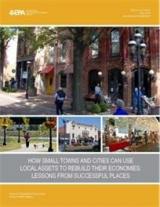Lessons From Successful Places
Over time, all communities experience changes that affect the industries, technologies, and land use patterns that help form the foundation of their local economies. Economically resilient towns, cities, and regions adapt to changing conditions and even reinvent their economic bases if necessary. Even if the community has lost its original or main economic driver, it has other assets that it can use to spur the local economy. While most economic development strategies involve some effort to recruit major employers, such as manufacturers or large retailers, many successful small towns and cities complement recruitment by emphasizing their existing assets and distinctive resources. This report examines case studies of small towns and cities that have successfully used this approach, including:
- Bend, Oregon (population 79,000).
- Douglas, Georgia (population 12,000).
- Dubuque, Iowa (population 58,000).
- Emporia, Kansas (population 25,000).
- Mount Morris, New York (population 2,900).
- Paducah, Kentucky (population 25,000).
- Roanoke, Virginia (population 98,000).
While no magic bullet or set process will work everywhere, these case studies illustrate several successful tactics that other communities can use:
- Identify and build on existing assets.
- Engage all members of the community to plan for the future.
- Take advantage of outside funding.
- Create incentives for redevelopment, and encourage investment in the community.
- Encourage cooperation within the community and across the region.
- Support a clean and healthy environment.
Learn more about smart growth in small towns and rural communities, and see our Publications page for more smart growth publications on business and economic development.
You may need a PDF reader to view some of the files on this page. See EPA’s About PDF page to learn more.
